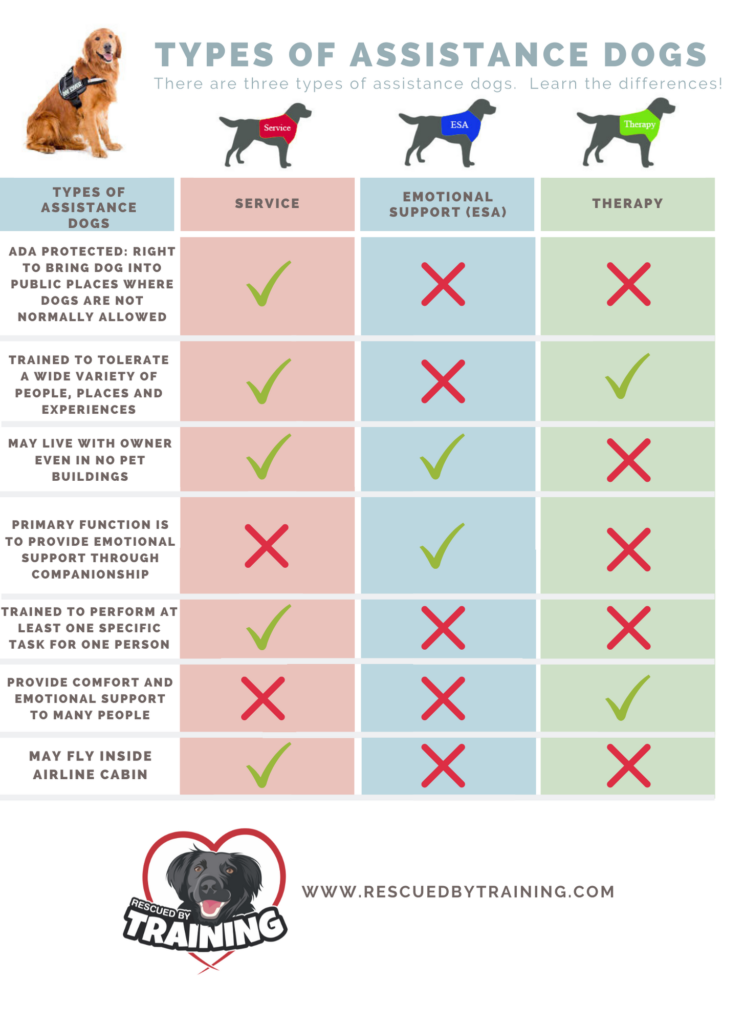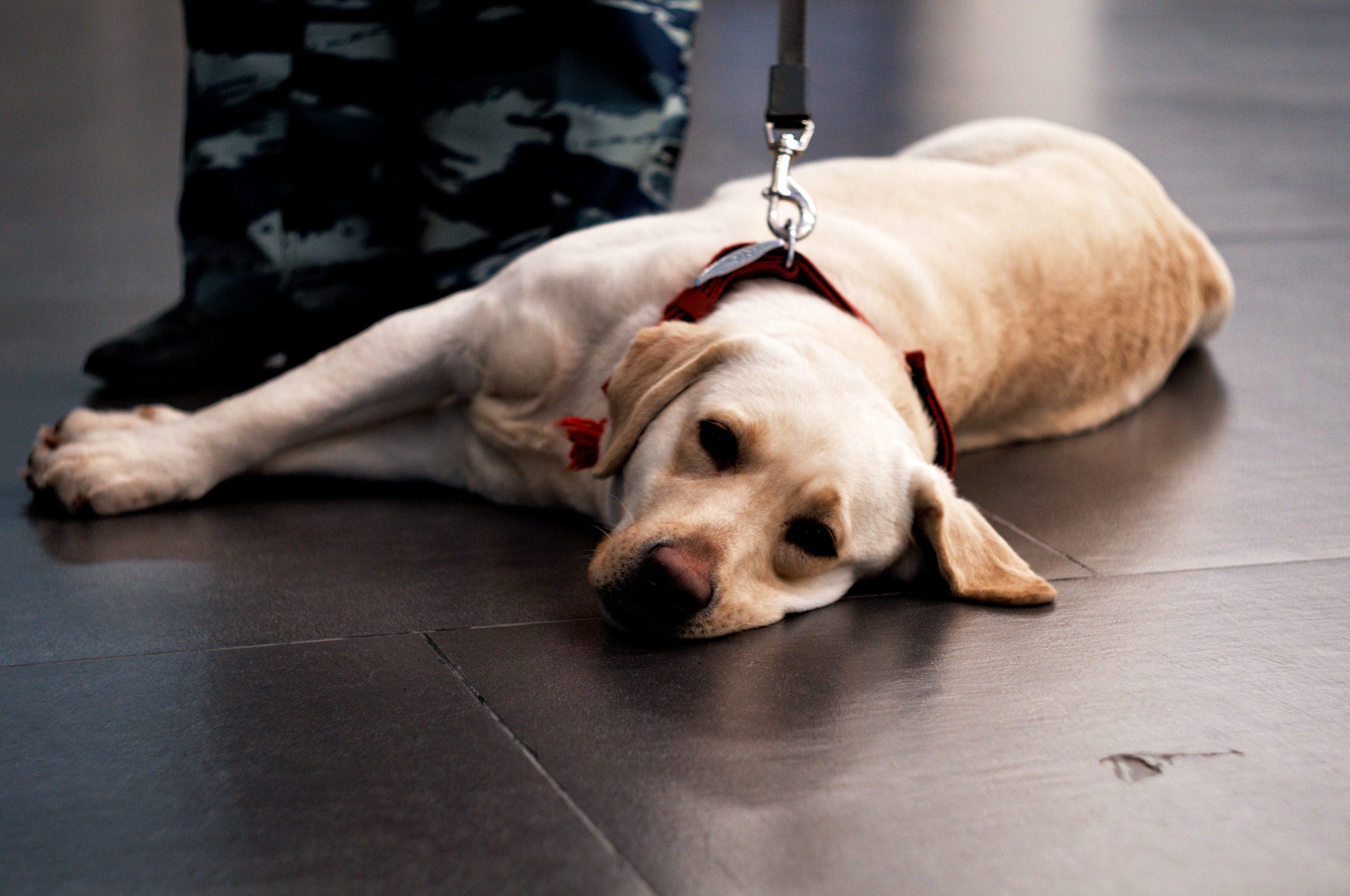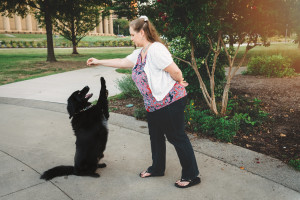(This post was updated June 15, 2021. Original post was December 20, 2019)
This past week a news story about a real service dog being attacked at mall in NJ by two unleashed dogs who were owned by a kiosk owner at the mall, initially claiming they too were service dogs. This turned out to be untrue.
So it’s a good time to review the types of assistance dogs, and their differences. There are three basic types of assistance dogs, all providing different tasks and support. You rarely have overlap, meaning you won’t find a service dog that is also a therapy dog. You could have a therapy dog that is also an ESA but that’s not common.
- Service Dogs: These dogs undergo hundreds of hours of specialized training to assist one person, who is disabled, by Americans with Disabilities Act criteria. They must be trained to perform at least one specific task for their person that the person could not otherwise do without the dog. They also undergo public access training, in addition to basic obedience. They are also trained to ignore high distractions including other dogs and people. These are true working dogs with the most widely recognized being seeing eye dogs. These dogs are given full protection under the ADA and are allowed to go into any establishment with their person, including restaurants and places dogs aren’t normally permitted. There is no official overseeing body for certifying service dogs, which is why it can be abused.
- Emotional Support Animals (ESA): These dogs (or sometimes other animals) are companion pets but their owner has been given a letter by a mental health professional stating having a companion animal will help their emotional well-being. These dogs are not granted any additional public access to places like restaurants or stores. ESAs can live in non-pet buildings. These dogs do not have any training or certification requirements at all. Prior to January 2021 they could fly in the cabin of a plane but as of January 2021, the US Department of Transportation changed their rules and now ESAs are considered pets and can only fly in cabins if they can fit under the seat and owners must pay the pet fee.
- Therapy Dogs: These dogs undergo specialized temperament and obedience training to allow them to go into places such as schools, hospitals, disasters and nursing homes to help offer comfort and support to strangers. They are not granted any special public access and their access is by permission only of the facility or location they are visiting. These dogs must be certified by a therapy dog organization who has tested them and they also often have an AKC CGC certification.
 Fake service dogs are rampant in my area and many others. This picture was sent to me by a friend at Busch Gardens. Dogs are not allowed there but this little dog, sitting in a wheelchair, has a service dog vest on. It’s easy to buy a fake vest and impressive looking card online but that doesn’t mean anything. I can usually spot fakers on a flexileash, with a red vest that says service dog, and the dog is often going off at people or other dogs. This abuse of an unregulated system is not only dangerous to other pets and people but hurts disabled people from having access to the things and places they need or causes their dog to be distracted when they’re working. As a result of the abuse, store owners are suspicious of people trying to pass off fake service dogs, disabled people are questioned, embarrassed or sometimes denied access. (I do not know for a fact this dog was fake, but I’d bet money on it based on this image.)
Fake service dogs are rampant in my area and many others. This picture was sent to me by a friend at Busch Gardens. Dogs are not allowed there but this little dog, sitting in a wheelchair, has a service dog vest on. It’s easy to buy a fake vest and impressive looking card online but that doesn’t mean anything. I can usually spot fakers on a flexileash, with a red vest that says service dog, and the dog is often going off at people or other dogs. This abuse of an unregulated system is not only dangerous to other pets and people but hurts disabled people from having access to the things and places they need or causes their dog to be distracted when they’re working. As a result of the abuse, store owners are suspicious of people trying to pass off fake service dogs, disabled people are questioned, embarrassed or sometimes denied access. (I do not know for a fact this dog was fake, but I’d bet money on it based on this image.)
In almost two dozen states, there are fake service dog laws and penalties. And airlines have begun to crack down on support animals with tighter restrictions after several people have been injured by traveling dogs.
What can you do? First, don’t ever try to pass off your companion dog as a service dog. And discourage friends and family members from doing it too. I know most people just love their dogs so much and want to be with them all the time, but there are rules in place for a reason. Second, learn the difference and help educate others. Not all assistance dogs are the same. Help spread understanding about the difference between a legitimate service dog, an ESA and a therapy dog.
HERE’S A QUICK REFERENCE GUIDE.

And lastly, be a good doggy owner citizen. If you are going to use your dog as an ESA, get them trained well. Don’t pass them off as a service dog if they’re not. Respect leash laws and don’t ask to pet working dogs. If you want to get your dog trained for public access or therapy dog work, seek out a qualified trainer or contact me. I offer remote sessions for many issues, or can refer you to someone who can help!
Happy training!
![]()





